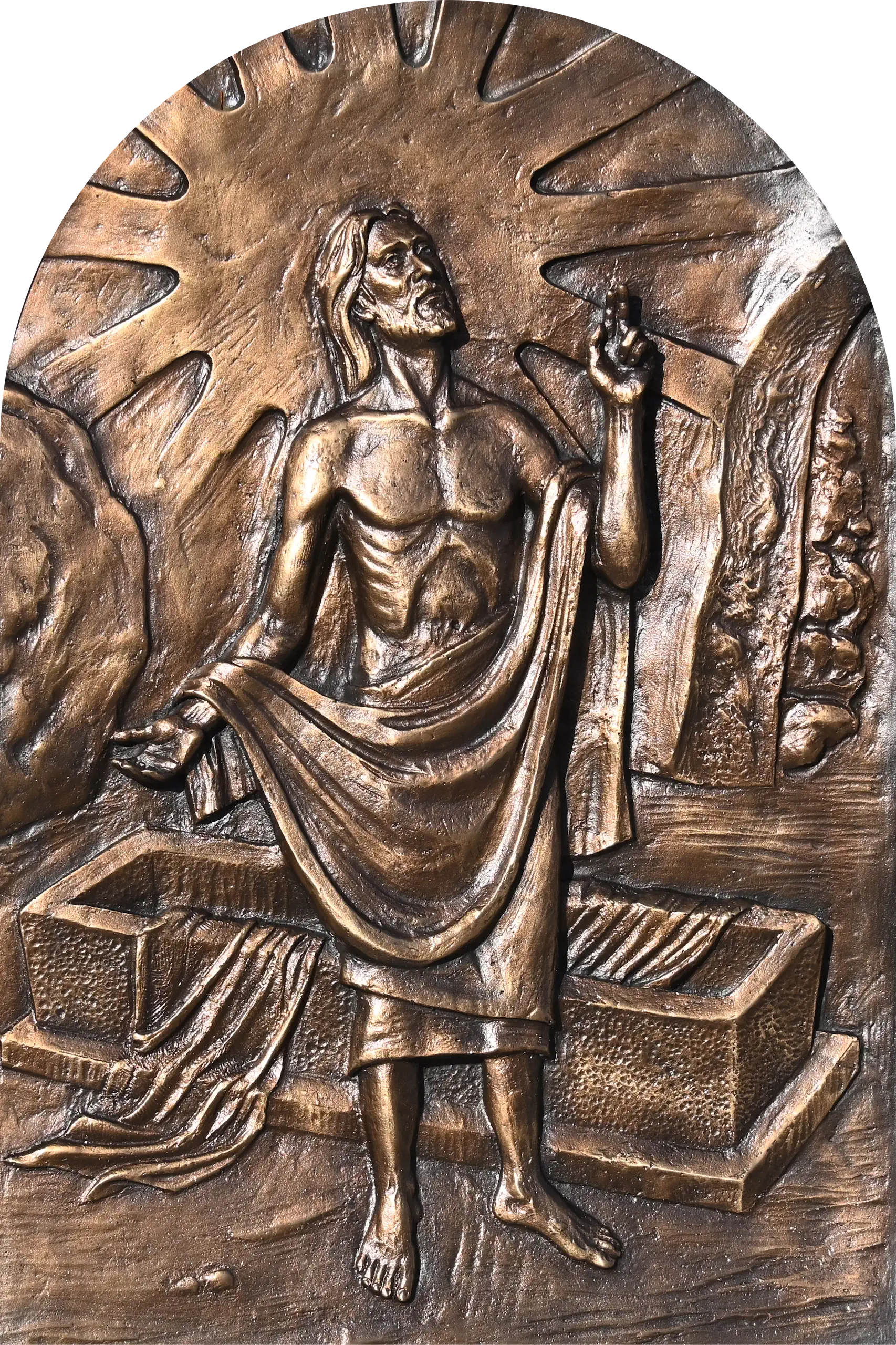
THE STATIONS OF THE RESURRECTION USING THE STATIONS OF THE CROSS
Stations of the Resurrection
Most churches have Stations of the Cross or the Way of the Cross, rarely do you see a church with the Stations of the Resurrection or the Way of Light. To help you pray the Stations of the Resurrection in church, the following looks at a scene from the Stations of the Cross and relates it to the same station number in the Stations of the Resurrection.
Stations of the Resurrection Using the Stations of the Cross
As you consider the image of Jesus before Pilate, think of it in the light of the resurrection. The story of the resurrection begins here and cannot begin without the condemnation. So, too, for us: as scripture says, “Unless a grain of wheat falls…” (John 12.24). See in this crucial moment of a death sentence for Jesus the sign of hope and resurrection for what seems hopeless in your own life. Give thanks, too, for those moments of resurrection where you have overcome a condemnation to live and fight another day.
As you stand before the image of Christ taking up his cross, think of the power of symbols. This is how hymn writer Brian Wren described the resurrection: “the cross stands empty to the sky” Consider, too, that in the Church of the Holy Sepulchre in Jerusalem, the tomb and Golgotha are under the same roof. They are both celebrated as signs of Christ’s triumph over death. What are the symbols of your own life? What are your signs of victory?
As you stand before the image of the first fall, notice how human a moment this is. This is true human frailty. The meeting with the Magdalene is the first recorded encounter that the resurrected Christ has with another human being, and Saint Mary’s human frailty leads to two almost opposite reactions. At first it prevents her from seeing Christ at all, and then, once she actually sees who it is, it makes her want to cling to him. When in your life has your frailty prevented you from seeing how important a person is to your life of faith, or else has made you want to control that which is meant to pass on?
In the Stations of the Cross, the meeting between Jesus and the Blessed Virgin is one of the most poignant images. You just wish you could reach out to console her and make things better. So, too, with the road to Emmaus. You just want to reach out and shake the two disciples and say, “Can’t you see who this is?” Think about the times when you have seen what others do not see and have been unable to act. Sometimes all we can do is to offer our presence to those in need, to be there in support as people learn some lesson the hard way.
Anything can be borne if it can be shared, they say. So, too, joy can be greater when you share it. At this moment, before the image of Christ sharing his cross with Saint Simon, think about those who are helping to carry your sorrows. Then stop and think about the finding of a lost coin or a lost sheep, or of a lost child (Luke 15), or even of a lost Lord. Recall those fleeting moments, but, even more, think about those with whom you have shared your greatest joys. Give thanks for both sorrows and joys, since both gave you graces from God.
To see someone’s face is to truly recognize them. To recall the face of someone who has died gets more and more difficult as time goes by: that is why we look at their pictures and so remember them. Here, before the image of Veronica wiping the face of our suffering Lord, it is easy to imagine that same face whose image remained on her veil appearing to the disciples in the upper room. Whether in sorrow on the way to crucifixion or in the joy of resurrected light, spend time contemplating the face of Christ that gives us hope.
So often in our lives we fall into sin. When we see Christ, the sinless one, falling under the weight of the cross of our sins, it is right that we see in this action the promise of forgiveness. In seeing this fall of Christ, we rightly contemplate the gift of peace and the power to forgive that was granted to the Church through these chosen disciples, who themselves were fallen and redeemed. Think about your own falls and one’s need for reconciliation.
When we think of Saint Thomas, we think of those whose faith (or lack of faith) is based only on what they see. As we consider the image of the women of Jerusalem, we think of people who are actually seeing something unfold before them that is so horrible, they cannot believe it is happening. At different moments of our lives, we fall into both of these camps. Spend a moment with these images and let them heal past events or strengthen your faith for what is to come.
As we consider the third fall of Jesus, it seems like this vision of the Stations of the Cross has come to the low point of Jesus’ participation in our human frailty. And so when we consider this appearance to the disciples in Galilee, we should see how these failed friends are rejuvenated from their lowest ebb, especially Saint Peter. The one who denied knowing him jumps from the boat to embrace the new life that he is only now starting to understand. In our own lives, it is good to know that we can hope for new life even in our moments of deepest sorrow.
In the Gospel, Saint Peter has all his defences stripped away as Jesus asks him again and again if he loves his Lord. So to consider the image of Jesus being stripped of his clothes is a perfect reflection on what happened to Saint Peter. It is also a reminder of what needs to happen to us. Think about all that hides our true selves from God. We need to come clean in order to be seen in our true selves and so be washed by the Spirit of God once again, as we were washed in our Baptism and are cleansed by the Mass and the sacrament of Reconciliation.
And so we come to the mountaintop moments: Golgotha and the Mount of the Ascension. We can add Ararat, Sinai, and Tabor to the list. In our life with God, there are mountaintop moments when things change forever. Think about the mountaintop moments in your life. Thank God for having lived to see those moments, and for having seen this and every day before and since those great events See them all as gifts from God, as opportunities to grow in love of God and neighbour.
“Goodbye.” It is a word we are often reluctant to say, especially when it is to someone who is going away for good. The image of Christ dying on the cross forces us to recognize the finality of life, just as much as the image of the Ascension reminds us that for Christians, life is changed, not ended, by death. The relationship between Christ and the disciples continues and in fact grows deeper after the Ascension. Think about how you will bring Christ crucified to the streets, to anyone who will hear, to the ends of the earth.
The Pietà. Just naming the image is enough to recall how the Blessed Virgin is integral to the Paschal mystery. And so the dead Jesus in her arms, taken down from the cross, is in a sense the mirror icon of Mary with the disciples waiting for the Pentecost of the Holy Spirit. We are not the authors of some of the most important things in our lives: we simply need to receive them. Whether as a burden or a gift. think about these events, these people, these challenges in your life and accept all of them for what they are: grace.
New life can explode into our lives in the most unexpected ways. Whether it is the tomb or the room with locked doors, these incubators can appear to be nothing more than hiding places. But suddenly there is resurrection, suddenly there is the gift of the Holy Spirit, and all heaven breaks loose on the world. Powerful soldiers become immobilized, the barriers of language become the occasion for a miraculous reversal of the sin of Babel, and we are all given the gifts of understanding and awe in the presence of a powerful God. The key is to be ready for when it happens!
Many churches do not have a fifteenth station, and so the Altar or the Blessed Sacrament Chapel are the suggested places to pray a fifteenth Station of the Cross, the resurrection of Christ, which is also the first station in the Stations of the Resurrection. Saint Paul, like the soldiers, is blinded by the light and struck down. The difference, of course, is that for Saint Paul, this is truly the first moment of the rest of his life, a life of running the good race, of proclaiming the Gospel in good times and bad. As we complete our meditation on the Way of Light, ask yourself how what God said about Paul applies to you: How are you an instrument whom God has chosen? (Acts 9.15).


